The Economics and Statistics Division maintains archives of previous publications for accountability purposes, but makes no updates to keep these documents current with the latest data revisions from Statistics Canada. As a result, information in older documents may not be accurate. Please exercise caution when referring to older documents. For the latest information and historical data, please contact the individual listed to the right.
<--- Return to Archive
For additional information relating to this article, please contact:
January 19, 2022ANALYSIS OF NOVA SCOTIA'S CONSUMER PRICE INDEX FOR ANNUAL 2021 CPI inflation in Nova Scotia increased 4.1% in 2021 following slower 0.3% growth the previous year. The annual CPI increase for 2021 was the largest since 1991 (6.0%).
Nova Scotia’s annual inflation in 2021 was higher compared to the national rate of 3.4%. Statistics Canada notes that the COVID-19 pandemic remained a key factor impacting prices with inflationary pressures stemming from global supply chain constraints and pent-up consumer demand as economy reopened. Inflation did pick up in the second half of the year. Atlantic Canadians had some of the faster rate increases while prices lagged the national increase in western provinces.
Higher energy prices lifted inflation directly through gasoline and fuel but also indirectly as key input into many production processes. Gasoline prices rose 36.1% in Canada and 39.3% in Nova Scotia in 2021.
Food prices were up 2.4% in Nova Scotia and 2.5% in Canada in 2021. Prices were up for dairy, eggs, and meat products. Meat prices were driven higher with labour shortages, production challenges, transportation costs, and strong demand in 2021. Seafood and other marine product prices rose 3.4% in Canada in 2021. Fresh vegetables prices declined 2.6% in 2021 with tomato and lettuce price falling.
Nova Scotia shelter prices rose 4.8% in 2021, the largest increase since 2008 (+7.1%). Canada shelter costs rose 3.9% as people looked for more living space and interest rates were at historic lows. Shelter price increases were largest in Prince Edward Island (+8.5%), followed by Nova Scotia. Homeowners' replacement costs increased faster than rent prices and mortgage interest costs were lower. Rent prices rose faster in Atlantic Canada than the national average.
Global supply chains contributed to higher for new passenger vehicles (+5.1%), furniture (+7.3%), and household equipment (+3.6%). Prices for smartphones/digital devices, computer equipment, and cellular services decline in 2021.
Overall good prices rose 5.6% in 2021, while service prices rose 2.5% in Nova Scotia in 2021. Nationally, service prices were up in part due to capacity restrictions, distancing difficulties and health and safety costs. Prices were up for restaurant, personal care services, and accommodation.
Prince Edward Island (+5.1%) posted the largest inflation growth among all provinces in 2021 while prices increased the least in Saskatchewan (+2.6%).

The CPI excluding food and energy increased 2.5% in Nova Scotia, higher than the national average of 2.3% in 2021. Quebec (+3.0%) had the largest increase for the CPI excluding food and energy while the smallest increase was in Alberta (+1.3%).
Average annual price increase excluding food and energy was faster in every province in 2021 compared to last year.
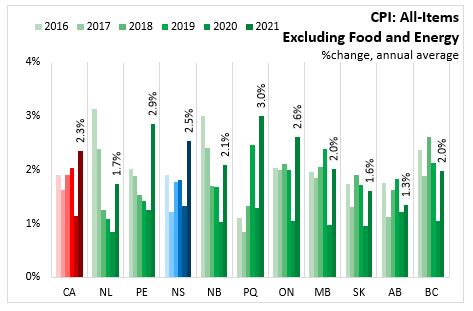

Major Components for 2021
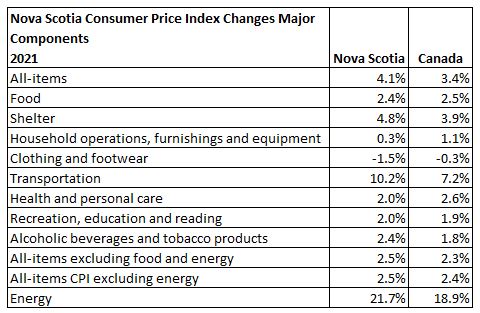
For Nova Scotia, prices increased in seven of the eight major components of the consumer price index in 2021 with clothing and footwear declining (-1.5%). Clothing and footwear prices decline for second consecutive year in both Nova Scotia and Canada. The fastest growing prices for Nova Scotia were in transportation (+10.2%) and shelter (+4.8%), both of which were significantly faster than Canada. Nova Scotia food and recreational, education and reading inflation were similar to Canada. Health and personal care (+2.0%) inflation was slower than Canada (+2.6%) while alcoholic beverages and tobacco products (+2.4%) was faster than in Canada (+1.8%).
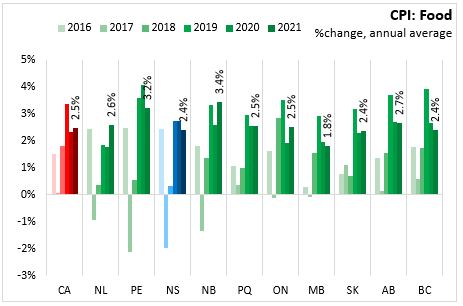
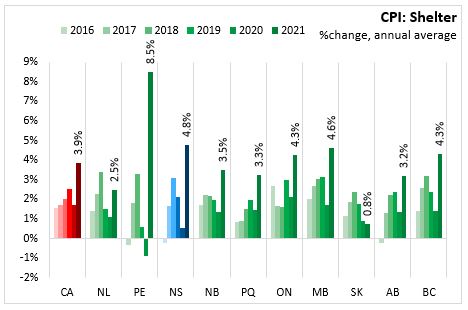

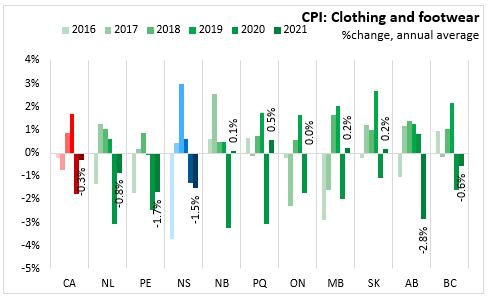




Following a decline in 2020, energy prices increased in every province in 2021 with Prince Edward Island (+26.6%) and Alberta (+26.0%) posting the largest gains. Nationally, energy prices were up 18.9% in 2021. Saskatchewan (+13.3%) posting the lowest gain.

Source: Statistics Canada. Table 18-10-0005-01 Consumer Price Index, annual average, not seasonally adjusted
<--- Return to Archive